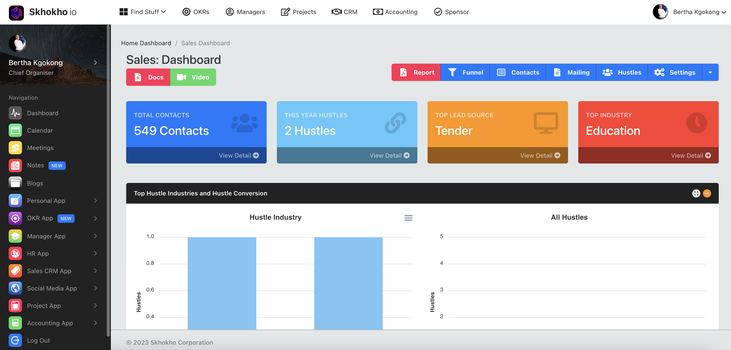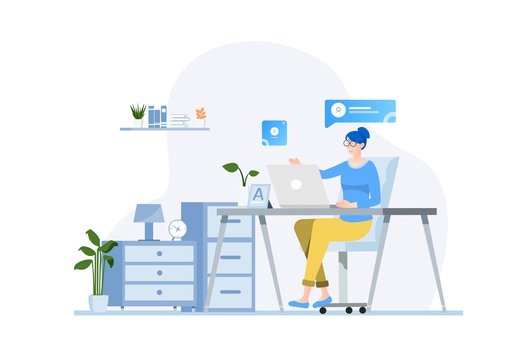Customer Orientation as a Competitive Advantage: Staying Ahead of the Game
In today's cutthroat business landscape, where innovation and differentiation are paramount, maintaining a competitive advantage demands a strategic focus on customer orientation. This approach, centered on understanding and fulfilling customer needs, has evolved from a mere buzzword to a crucial driver of sustainable success.

In this blog, we delve into the power of customer orientation and how it can propel businesses to stay ahead of the game.
We will focus on the following topics:
- Definition and Importance of Customer Orientation
- Key Elements of Customer Orientation
- Essential Components of Customer Orientation
- Benefits of Customer Orientation
- Strategies for Developing a Customer-Oriented Culture
- Leveraging Skhokho Sales & CRM
Definition and Importance of Customer Orientation
At its core, customer orientation is the business philosophy of putting customers at the heart of every decision. It means understanding their preferences, expectations, and pain points to tailor products and services accordingly.

This approach is not just a nicety; it's a strategic imperative. Companies that prioritize customer orientation enjoy a sustainable competitive advantage. Why? Because they forge stronger connections, creating loyal brand advocates who not only come back for more but also spread the word.
Key Elements of Customer Orientation
Customer orientation is not a one-size-fits-all concept. Different industries, business models, and markets may have unique nuances when it comes to understanding and serving customers. However, certain fundamental elements underpin an effective customer-oriented approach across the board. Here's a closer look at these pivotal aspects:
Deep Customer Understanding:
At its core, customer orientation requires a profound understanding of who your customers are, what they want, and how they think. This goes beyond mere demographics to encompass psychographics, behavior, preferences, and pain points.
Proactive Feedback Mechanisms:
Implementing regular channels for customer feedback, such as surveys, focus groups, and one-on-one interviews, is crucial. This allows businesses to preemptively address concerns and adapt to changing needs.
Employee Training & Development:
Staff at all levels should be trained to think from a customer’s perspective. By developing a workforce that values and understands customer satisfaction, businesses can ensure consistent, high-quality service.
Agile Adaptability:
The ability to quickly pivot based on customer feedback and market changes is vital. In the fast-paced digital age, businesses that can adapt and evolve their offerings in response to customer demands will thrive.
Holistic Experience Design:
A customer-oriented approach isn't limited to the product or service but encompasses the entire customer journey. From the initial touchpoint, through the purchase process, to post-purchase support, every interaction should be designed to optimize the customer experience.
Data-Driven Decision Making:
Leveraging data analytics tools can provide invaluable insights into customer behavior and preferences. By using this data, businesses can make informed decisions that resonate with their target audience.
Building Trust and Long-Term Relationships:
Trust is the foundation of customer loyalty. Companies that prioritize honesty, transparency, and consistency in their interactions foster deeper, lasting connections with their clientele.

Collaborative Approach:
Internally, fostering a culture where departments collaborate and share insights about customers can lead to a more comprehensive understanding and more effective strategies. Externally, partnering with stakeholders and even customers for co-creation or feedback can further enhance the orientation.
Leveraging Skhokho Sales & CRM: Pioneering Customer Orientation
In the digital age, where data is the new currency and personalization is king, the utilization of advanced Customer Relationship Management (CRM) systems has become a game-changer. One such system that stands out in the realm of customer orientation is the innovative Skhokho CRM.
Skhokho Sales and CRM is a software or tool that companies use to store and record activities related to client records and sales efforts. It is designed to help businesses manage their sales leads, record all the information with regards to sales leads, record lead documents, meetings and notes for future reference, create contact groups and mailing lists, and keep all sales documents in one place. It also provides features such as group emails, meeting management, and sales notes.

Skhokho Sales and CRM also allows users to send emails directly from their company email servers, to build credibility with clients and create more authentic email communications. All data is stored in secure cloud servers with best in industry security and firewalls.
With its comprehensive suite of tools and features, Skhokho CRM empowers businesses to not only understand their customers but to anticipate their needs and desires, placing them at the forefront of the customer orientation movement.
Unveiling Insights with Skhokho CRM
Through intelligent data analysis, businesses can discern patterns, uncover hidden trends, and tailor their offerings to resonate with their audience on a profound level. Companies using Skhokho CRM can position themselves as true allies in their customers' journeys.
Seamlessness and Connectivity
Skhokho CRM transcends silos within an organization, fostering seamless communication across departments. Sales and marketing can collaborate effortlessly, ensuring that each customer touchpoint is cohesive and informed. This synergy creates a unified customer journey, where interactions are consistent, irrespective of the point of contact. As a result, customers feel understood and valued at every step of their engagement.
The Skhokho Advantage
Skhokho CRM isn't just a software—it's a philosophy of customer-first thinking. By harnessing its power, businesses can cultivate a culture that values each customer interaction as an opportunity to create a positive and memorable experience.
Through its robust capabilities, Skhokho CRM empowers companies to not only stay ahead of the competition but to define new standards of excellence in customer orientation.

Incorporating Skhokho CRM into your business strategy is more than adopting a tool; it's embracing a philosophy that places customers at the heart of every decision. As we navigate the intricacies of the modern business landscape, the Skhokho CRM becomes a guiding light, illuminating the path towards unparalleled customer orientation.
Essential Components of Customer Orientation: Crafting Unforgettable Experiences
The Power of Personalization
Personalization lies at the heart of unforgettable experiences. When customers see products or services tailored to their preferences, they feel a deeper connection to the brand. Imagine logging into a website and finding product recommendations that align perfectly with your past purchases or interests—this sense of being understood enhances trust and loyalty.
Seamless User Experiences Matter
The journey a customer undertakes, whether on a website, an app, or even in a physical store, should be smooth and enjoyable. Eliminating any barriers or friction points and ensuring the path is intuitive can make all the difference in how a brand is perceived. A clear, easily navigable interface can often be the difference between a one-time visitor and a repeat customer.

The Impact of Prompt Customer Support
Even in the best-run businesses, issues can arise. However, it's not just the problem but the response to it that shapes the customer's view. Offering prompt, friendly, and efficient support not only resolves issues but can turn potential negatives into positive touchpoints, reinforcing the brand's commitment to its customers.
Consistency in Brand Messaging
Every interaction with a customer, be it digital or physical, should echo the brand's core messages and values. This consistency fortifies the brand's image, making it recognizable and reliable. Think of it as the familiar tune that customers can hum along to, no matter where they engage with the brand.
Going Beyond with Value-Added Services
Customers cherish businesses that offer more than just a product or service. By introducing value-added services like loyalty programs or complimentary workshops, brands can demonstrate their commitment to providing extra value and enhancing the overall customer experience.
Storytelling: A Unique Connector
Stories resonate. They evoke emotions, values, and memories. By weaving engaging narratives about the brand's journey, values, or impact, businesses can create a unique bond with their customers, making each interaction memorable.
Feedback as a Two-Way Street
A relationship is built on communication. By establishing feedback loops and genuinely acting on customer insights, brands can show that they value and respect customer opinions, strengthening the bond of trust.
Anticipating Needs for a Wow Factor
Proactive service can be a game-changer. Anticipating potential customer needs or challenges and addressing them before they arise can leave a lasting positive impression, positioning the brand as genuinely caring and forward-thinking.
Building Emotional Connections
Customers are not just looking for products or services; they seek connections. Brands that tap into the emotional drivers of their audience, understanding and mirroring their aspirations or values, can foster deeper, more meaningful relationships.
Quality: The Non-Negotiable Component
At the end of the day, no amount of branding or storytelling can make up for a lapse in quality. Ensuring that every product, service, and interaction is top-notch is the bedrock of a memorable customer experience. Brands that prioritize quality at every step build a reputation that keeps customers coming back.

Understanding Customer Needs: A Deeper Connection
The cornerstone of customer orientation lies in the ability to truly understand what customers need, often before they themselves are aware of it. This goes beyond surface-level interactions and delves into empathetic comprehension. By conducting in-depth market research, analyzing customer behavior, and actively listening to feedback, businesses gain invaluable insights into the desires, pain points, and aspirations of their customer base. This understanding is the bedrock upon which personalized experiences and tailored solutions are crafted.
Strategies for Developing a Customer-Oriented Culture
First and foremost, leadership plays a crucial role. Leaders must not only talk the talk but walk the walk. Their behavior sets the tone for the entire organization. When leaders prioritize customers, make decisions keeping them in mind, and demonstrate a commitment to serving them, the ripple effect is felt throughout the company. Employees, irrespective of their roles, begin to view their tasks through a customer-centric lens.
Training is another essential tool. Investing in consistent and comprehensive training ensures that every team member understands the importance of the customer. It's not just about teaching customer service techniques; it's about instilling a mindset where customer satisfaction becomes the ultimate goal. Real-life case studies, role-playing exercises, and discussions can be used to highlight the implications of a customer-focused approach versus a product-centered one.
Communication is the lifeblood of any organizational culture. Open channels of communication foster an environment where feedback, whether from customers or employees, is valued and acted upon. Encourage teams to share customer testimonials, feedback, stories, and even criticisms. This keeps everyone in the loop about customer expectations and challenges.

Recognizing and rewarding customer-centric behavior is also vital. When employees go above and beyond to ensure customer satisfaction, celebrating their efforts sends a powerful message. It underscores the company's commitment to a customer-first approach and motivates others to follow suit.
But it's not just about external customers. Developing a customer-oriented culture also means treating employees as internal customers. When staff feel valued, heard, and empowered, they, in turn, are more likely to extend the same care and commitment to the external customers they serve.
Lastly, data plays a pivotal role in the modern business landscape. Use analytics to gain insights into customer preferences, behaviors, and pain points. Understanding the customer's journey, backed by data, can guide tweaks and changes to processes, products, or services, ensuring they align with customer needs and expectations.
Ready to Revolutionize Your Customer Orientation? Try Skhokho CRM Today!
Elevate your business's customer orientation game by taking the first step towards a transformative journey.
With Skhokho CRM, you're not just getting a software—you're unlocking a world of unparalleled insights, personalization, and proactive engagement. Click here to register and enjoy 14 day free trial. Do not worry, Skhokho provides a Documentary and YouTube Tutorials to make it easy for you.









